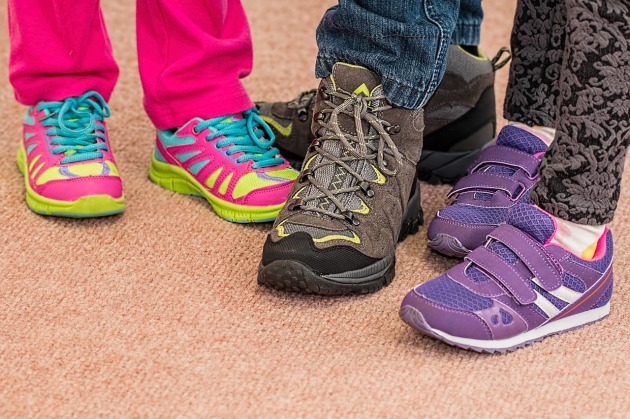3 Easy Steps for Choosing Shoes for Children
August 19, 2019
By Jennifer L Flo, DPM
It’s back to school time, so let’s help kids put their best feet forward. Here are three guidelines for purchasing new shoes for children.

1. Get the Correct Fit
Your kids just won’t stop growing! So have a knowledgeable person measure their feet, not just in length but width as well, with a Brannock Device (that clunky metal measuring thing). Wearing shoes that are too tight can lead to painful blisters, calluses and ingrown toenails. Wearing shoes that are too large can lead to tripping and falling.
Our feet swell and expand a bit throughout the day, so shop for shoes in the afternoon when feet are maximally puffed up. Make sure the child is wearing the type of socks he or she usually wears.
Here is a general guide to how often kids need their feet measured:
Toddlers: Every 3 months
Ages 2 and 3: Every 4 months
Ages 3 through 8: Every 6 months
Ages 9 through 12: Every 6-12 months
2. Check the Shoe from Heel to Toe
The heel should be firm and shouldn’t collapse when you squeeze it from the sides. The sole should be sturdy in the arch area because the arch of the foot needs firm support.
The only place a shoe should bend is where the toes bend. Look for room in the toe area. A thumb’s width or a half-inch from the end of the longest toe to the end of the shoe is the ideal space. This will prevent that toe from hitting the front of the shoe and causing damage to the nail. Many ingrown toenails happen because of pressure from a shoe that fits too tight.
3. Choose the Right Shape and Style
The shoe should be lightweight and shaped like the foot (a rectangle, not a narrow pointy triangle).
Some kids need arch supports because they are experiencing foot or leg pain or frequent sprains that interfere with their activities. You can make room in the shoe for the arch support by taking out the inner sole.
When Choosing Athletic Shoes
• Avoid slip-ons because athletic shoes must provide maximum support and be secure on the foot.
• Do not use second-hand shoes or hand-me-downs for athletic shoes. Every foot is unique and wearing shoes with another foot’s wear patterns already established can lead to problems.
• Buy running shoes for track, soccer cleats for soccer, etc. Cross-trainers work well for kids who play multiple sports.
Dr. Jennifer Flo is a podiatric physician at NOMS Ankle & Foot Care Centers. For more information on foot health or to schedule an appointment, contact one of our 20 conveniently located offices by visiting http://www.NomsHealthCare.com.
You must be logged in to post a comment.